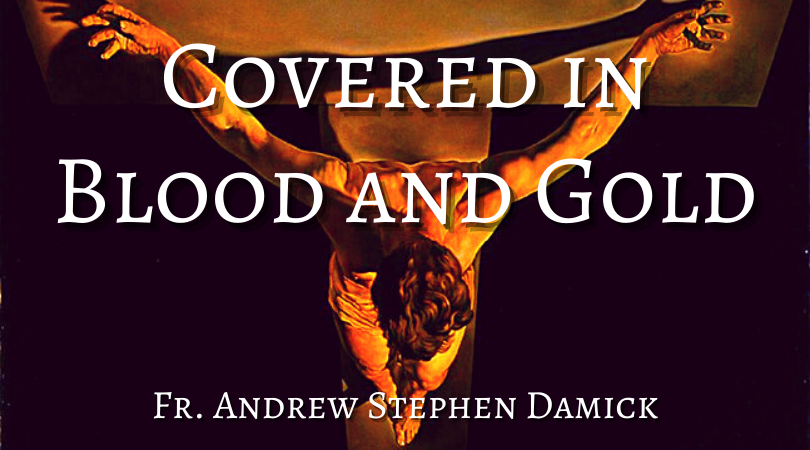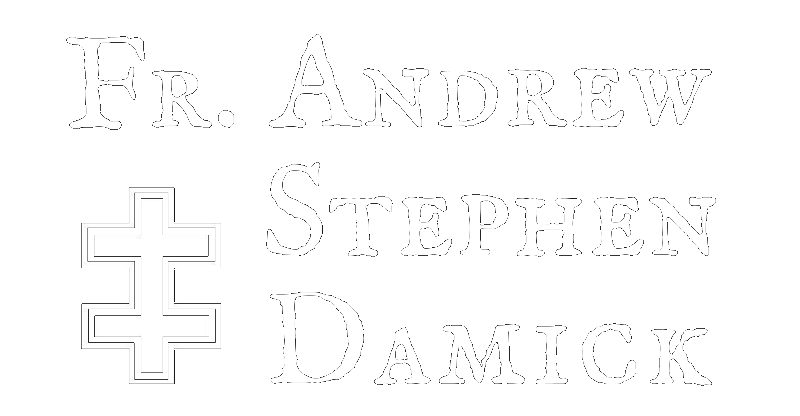
Procession of the Precious and Life-Giving Cross, August 1, 2021
Romans 12:6-14; Matthew 9:1-8
In the Name of the Father and of the Son and of the Holy Spirit, one God. Amen.
On the first day of August, we celebrate one of the minor feasts of the Cross of Christ, which is called the Procession of the Cross. This feast was instituted in the city of Constantinople in August because of the many summer diseases that spread there at that time. Fragments of the wood of the Cross of Christ would be processed throughout the city as a way to counteract the spread of disease. So it is about this feast and about Christ’s Cross that I would like to speak today.
A few of you know that I have been studying in an MA program this year, and the class that I have just wrapped up this summer was an introduction to translating Old English. Old English is the very earliest period of our language, dating roughly from the fifth century to the eleventh. Sometimes people refer to the style of English we use in our services and can be found in, say, the works of William Shakespeare as “old English,” but that actually is simply Early Modern English. Old English is incomprehensible to Modern English speakers who have not studied it.
The Old English corpus of texts dates almost entirely from before the Great Schism of the Church, when the Roman Catholic Church broke from the Orthodox Church in the eleventh century. And the vast majority of the texts extant in Old English are Christian texts. The very earliest piece of English poetry, for instance, is Cædmon’s Hymn, a hymn in praise of the Creator written by Cædmon of Whitby, who is a saint of the Orthodox Church. So that means that these are texts written by Orthodox Christians living in England, mostly over a thousand years ago. And that means that they are an integral part of the tradition of Orthodox Christians, especially those of us who speak English.
I mention all this because there is an Old English poem dating from at least the eighth century that I would like to share with you today, and it is titled The Dream of the Rood. Rood is an archaic English word meaning “cross,” and it survives today in our Modern English word rod. This poem is a vision of the Cross of Christ, described as received in a dream. In it, the narrator sees Christ’s Cross, which actually speaks to him.
I am going to share a few fragments of this poem with you, in my own rough, very literal, student-level translation into Modern English, so that you can get some sense of it.
Lo! I of the best of dreams wish to tell
what came to me in dream. In the middle of the night
after those who speak were in bed
it seemed to me that I saw a wonderful tree
lifted on high by the light enwrapped,
brightest beam. All that Sign was
covered with gold…. (ll. 1-7a)I saw that brilliant Beacon
change by clothing and color: at times it was with blood suffused,
drenched with blood’s passage, at times with treasure adorned.
Nevertheless, I lying there a long while,
beheld the sorrow-troubled Savior’s Tree,
until I heard it call out;
it began then to speak word, the best of words: (ll. 21b-27)“I saw then Mankind’s Lord,
hasten with great zeal that He would climb up on me.
There I then dared not, against the Lord’s word,
to bow or to burst when I saw tremble
the surface of the Earth. I might all those
enemies have laid low, yet I stood fast.
The young Hero stripped Himself for battle – that was God Almighty –
strong and unflinching; He climbed on the high gallows,
bold in the sight of many, that He would redeem mankind.” (ll. 33b-41)
This is just a few fragments of the poem, but enough to give you the idea of both the narrator and then the Cross as it speaks to him in his dream.
When the dreamer sees the Cross, his vision begins with seeing the cross covered in gold, wrapped with light, studded with gems. But then the vision changes, and what he sees alternates between that golden, treasure-laden image and an image of rough pieces of wood, suffused with blood and stained by blood-flows.
Then when the Cross speaks, it tells of seeing Christ Himself, “Mankind’s Lord,” “hasten with great zeal” to climb up on the Cross. He sees Christ ready Himself as a warrior for battle, “strong and unflinching,” “bold in the sight of many,” climbing up on the Cross “that He would redeem mankind.” So the narrator speaks of seeing the Cross, and the Cross speaks of seeing Christ.
This poem illustrates powerfully something that we as Orthodox Christians know deeply to be true—that every material reality has a spiritual aspect to it, that the seen and the unseen are deeply intertwined.
This dream-vision shows this truth first by the image of the Cross as interchangeably a bloody piece of wood and a gold-covered, gem-encrusted Beacon. By this image we see the material truth of what happened there—a Man was crucified, who had been scourged and beaten and crowned with thorns. This sight is true, but it is all that can be seen with eyes that are not illumined by faithfulness.
The eyes of the faithful, while in no way denying or blind to the suffering of Christ, also see what the poem in another section calls “the Tree of Glory / honored with garments, with joy shining, / dressed with gold” (ll. 14b-16b). The Cross of Christ is a glorious bearer of the power of God Himself, with all its healing and joy and victory over demons, sin and death.
When the Cross speaks in the poem, it describes Jesus not as a helpless victim. You might ask why it leaves that out. It actually does not, but the helplessness is transferred and used to describe itself in a passage that I did not read to you (ll. 28-33a), where it speaks of being cut down by the enemies of God, set upon a hill, and forced to bear criminals. So the Cross itself becomes the image of the victimhood of Jesus.
The Cross in the Dream gives an image of Jesus Himself as a ready, valiant, eager Warrior, who climbs up voluntarily on the Cross. He is ready to do battle, “bold in the sight of many.” This theme of Jesus as an eager warrior is frequently found in Old English poetry. Some have commented that this represents a syncretism between Christianity and Old English Germanic heroic warrior culture, that this is almost a paganized view of Christ.
Orthodox Christians know, however, that Christ is depicted in our own hymnography as readily climbing on the Cross. The very apolytikion of the Resurrection that we sing today says “He took pleasure in ascending the Cross in the flesh to suffer death and to raise the dead by His glorious Resurrection” (Apolytikion of the Resurrection, Tone 5). That phrase “He took pleasure” in the Early Modern English we use in our services means simply that He was willing. The image of Christ ascending the Cross—rather than simply being nailed to it by Roman soldiers—is well-known to us. And the Lord Himself says that no one takes His life from Him but that He laid it down of His own accord (John 10:18).
If we had stood at Golgotha on the day of the Crucifixion, our material eyes would have seen Roman soldiers nailing Jesus to the Cross. But our eyes of faithfulness would have seen the young Warrior, ready to do battle, about to use this Weapon of Peace, the Trophy Invincible, as His means to enter into Hades, smash down its doors, and to defeat the devil and death.
If you participate in the services of the Church, then you see both these realities simultaneously. This truth shines forth perhaps most brilliantly in Holy Week, where we feel both the agony and sorrow of Christ’s passion as well as the glory and victory of His destruction of death and giving resurrection to the fallen.
On this feast of the Procession of the Cross, we look to the Cross, and we see both the blood-suffused wood, cut from the forest and made to stand upon a hill of death, and this Tree of Glory, this bright and brilliant Beacon and Sign. We also see the silent, humble Sheep led to the slaughter, the Lamb slain from before the foundation of the world, Who is also the victorious, glorious Warrior Who is eager to redeem mankind.
To that crucified, risen Jesus Christ, with His Father and the Holy Spirit, be all glory, honor and worship, now and ever, and unto ages of ages. Amen.



